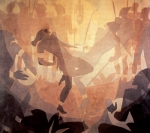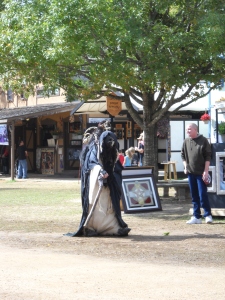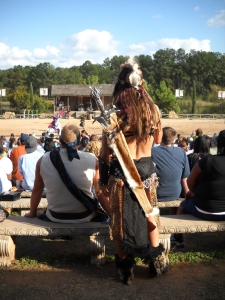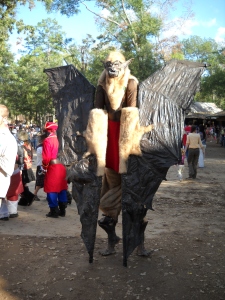Text by Lynn C. McDaniel, Communications Specialist for the University Art Department
This past Thursday, February 21st, at our monthly brown bag lunch and lecture, Professor Violet M. Showers Johnson presented an extremely interesting lecture which she called Ambivalent Aesthetics: West Indians, Garveyites and the “New Negro Art” of the 1920s and 1930s.
The Forsyth Learning Gallery was filled with guests, who listened as Professor Johnson discussed the emergence of the “New Negro”. She explained that, following the Civil War, the failure of Reconstruction, and the black migration to the Northern States, black people began questioning who they were. Were they African? Many black people came from places other than Africa (such as the West Indies), and many were born in America—a generation or two away from Africa. Were they American? Technically, yes, but they were culturally undervalued in a nation deemed to be “white, Euro-American.” Were they slaves? No, they had their freedom, and yet they were still looked upon as inferior and were segregated in society, even by the Northern black people, who considered them trouble-makers.

The 1920s and 1930s represented an age of vibrancy, energy and change. It was the era of The Cotton Club and similar clubs in Harlem, where largely white audiences enjoyed shows performed by black entertainers. Called “the Harlem Renaissance,” this period represented a time of growth and self-reflection for black people who asked themselves, “Who am I? What does it mean to be black?” The “New Negro” discovered a newfound self- and racial-pride, and expressed that confidence through music, literature, theatre, dance and the arts.
In her description of what her presentation would be about, Professor Johnson stated, “The diverse creations of the New Negro Art validated and highlighted the African past of African Americans while situating them at the center of contemporary American life and culture. At the same time that African American artists, scholars and activists were advocating this hybrid art movement, immigrants from Caribbean British colonies (the West Indies) were grappling with their multiple identities as British subjects and Blacks in America. Nevertheless, as staunch adherents of the United Negro Improvement Association (UNIA), founded by Jamaican Marcus Garvey, many West Indians were in the forefront of Black Nationalism and the celebration of black aesthetics. This presentation will describe, discuss and illustrate the immigrants’ conflicting encounters with American ‘New Negro Art’ while balancing imperial belonging and the Black immigrant experience.

Professor Johnson offered two examples of visual art which depicted the energy, vibrancy, and conflict of the “New Negro” movement. The first, Loïs Mailou Jones’ painting, Les Fetiches, 1938, is a powerful painting of an African mask, which was a perfect symbol for this time of self-evaluation, question and discovery.

The second example was Aaron Douglas’ Study for Aspects of Negro Life: The Negro in an African Setting, 1934, again, a vivid portrayal of dynamacism, joy and life that was evident in the “New Negro”.
Without question, the cultural impact of this movement–on all forms of the arts–was significant, and helped give a mighty voice to black people that they had never had before. In the two decades that it lasted, the New Negro Art movement inspired significant changes in numerous other aspects of society as well, slowly contributing to the breaking down of racial barriers and integrating society, proving that art truly is the universal language.
Guests of the brown bag lunch and lecture series, which is held from Noon to 1:00 every third Thursday, are always encouraged to bring their lunch to enjoy during the lecture, and then participate in a lively discussion afterward. The Forsyth invites you to join us and learn more about art and how it affects our world.
Violet M. Showers Johnson is Professor of History and Director of Africana Studies. She is the author of The Other Black Bostonians: West Indians in Boston, 1900-1950. For more information about the Africana Studies Program, please contact Ms. Johnson.








